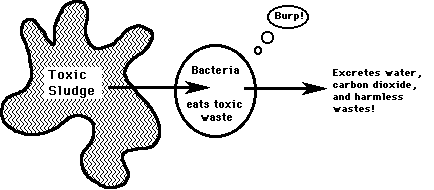Bioremediation
Bioremediation is a relatively new way to cleanup toxic waste
by using bacteria that have been found in nature that will convert the toxic
substance to safe substances. In somecases, bacteria may be genetically engineered
to destroy the toxic waste.
Usually, the bacteria are sprayed onto toxic chemicals lying
on the ground (such as used to cleanup the oil spill of the Exxon Valdez in
Alaska), or the bacteria may be released into an aquifer via a well. The bacteria
spread, and when they find the toxic waste they like to eat, they break it
down into non-toxic substances. As they eat, they also begin to reproduce
and multiply in numbers. The more bacteria there are, the faster the wastes
are cleaned up.

Cost: $10 million/ about $200 extra/
year on tax bill.
Pros
1. Relatively inexpensive.
2. No buildings need to be dug up and removed.
3. Works over large areas (especially above ground).
4. This method is quick (above ground) or slower underground
(where the water moves more slowly).
5. This method has been used effectively on oil spill cleanups
in the past.
6. As long as there is toxic waste, the bacteria continue to
feed on it. Thus, they may eventually cleanup the entire site!
Cons
1. Hard to control where the germs (bacteria) go.
2. Some people are concerned about having lots of germs spread
around.
3. Some people are concerned that some of the germs may be
able to kill people or make them sick. In most cases, bacteria that eat toxic
waste are probably not able to make people sick.
4. Many people around the world are concerned about the use
of something that is not natural, that has been genetically engineered as
many of the bacteria used for toxic cleanup have been!
Links:
Dangers
of Genetic Engineering- This involves food, but the risks may be similar
to those involved when bacteria are engineered to remove a toxic substance
from our environment.
